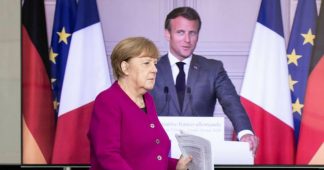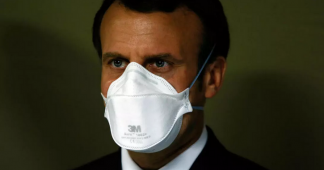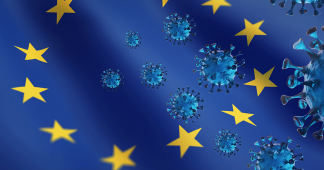As a follow up to the joint proposal of Germany’s Chancellor Angela Merkel and French President Emmanuel Macron on creating an EU Recovery Fund of €500 billion, the European Commission presented a package of €750 billion called ‘Next Generation EU’. For a very informative mainstream assessment from the Brussels based Bruegel think tank see here. On their line of ‘further thinking’, see here. I would only agree to their final statement: “As the Chinese proverb goes, a bad beginning leads to a bad ending.”
According to the Commission, the funding shall assist EU member states to tackle the economic and social consequences of the recession following the ‘Great Lockdown’ of the Corona Crisis, with a special focus on the ‘Green Deal’ and digitalization. €500 billion shall be made available to member states as grants, as proposed by Merkel and Macron, and €250 billion as loans. ‘Mix and match’ – Ursula von der Leyen hopes that with this approach she can lure those EU governments which criticized the Merkel/Macron initiative into some compromise.
Controversy: grants vs. loans
Earlier on, the governments of Austria, the Netherlands, Denmark and Sweden (the ‘frugal four’) insisted that Recovery Fund monies should be made available only as loans, with strict conditionalities on economic ‘structural reforms’. This controversy is far from over. Also Hungary’s President Viktor Orban strongly opposes the Commission proposal, claiming “that the new distribution system that they presented to us is an absurd and perverse solution, because it gives more resources to the rich than to the poor.”
Concerning the rescue measures already under way, Orban has a point: German companies have benefited from around half of the ‘Corona’ state aid provided across the EU, while 18 percent has gone to Italian firms and only 4.3 percent to Spanish businesses. According to an internal paper of the Commission, Italy would be the largest beneficiary of the Recovery Plan, eligible for about €172.7 billion. Spain (140.4 billion) would come second, followed by Poland with €63.8 billion. But Hungary would receive just €15 billion. Further controversies on the Commission’s proposal are to be expected.
The ‘frugal four’ warn about the mutualisation of debt. They claim, that the EU is becoming a ‘Schuldenunion’ (debtors union). And also a ‘transfer union’, because ‘sound economic management’ as theirs would not be appreciated. Instead, so they fear, the economically righteous EU members would have to pay for the ‘irresponsible Club Med of the EU South’. This was a theme propagated by German ordo-liberals already at the early discussions on the ‘feasibility’ of the euro in the 1990ies. These propagated a ‘core Europe’ strategy for joining the Euro – the ‘dolce vita’ South should be excluded from accessing the eurozone.
According to the Commission, “Next Generation EU will raise money by temporarily lifting the own resources ceiling to 2.00% of EU Gross National Income, allowing the Commission to use its strong credit rating to borrow €750 billion on the financial markets. This additional funding will be channelled through EU programmes and repaid over a long period of time throughout future EU budgets – not before 2028 and not after 2058.”
Euro-bonds reloaded?
Note that this is a different concept compared to the earlier discussions about euro-bonds, or recently corona-bonds as propagated mainly by the Italian government. With their share of euro-bonds, national governments would have been able to spend the monies generated from that as they would see fit. According to the Merkel/Macron proposal and the Commission’s project, they would be obliged to apply for concrete projects under the EU programmes which are being envisaged, following the established EU rules and procedures on these.
The Commission proposes a new Recovery and Resilience Facility of €560 billion and states: “This facility will be embedded in the European Semester.” So, on the bulk of the €750 billion Recovery Plan, the rules and conditionalities of the European Semester shall apply (which are often biased towards neo-liberal ‘structural reforms’).
Also, be careful about the ‘numbers’ that the Commission puts forward. As Emma Clancy explains: “The von der Leyen proposal for a budget of €1.1tn is slightly higher than what is currently on the table at the Council but still represents a retreat from the Commission’s original proposal. (…) If we remove all the spin, the amount of real new funds from the EU for this recovery plan is €310bn. It is not an insignificant sum, and it has been welcomed by countries such as Italy and Spain. But it is nowhere near the €2.4 trillion touted by von der Leyen in her speech. Even the proposed €750bn in borrowing is in reality less than what was put forward in the German-French plan for €500bn in grants. Crunching the numbers, Eurointelligence estimates that the recovery element of the package amounts to an annual 0.56% of the EU’s 2019 GDP, for four years.” Wow – what a ‘bazooka’ of ‘financial firepower’ from the EU level …
EU joint liability for debt?
The repayment of the monies borrowed from financial markets by the Commission would be handled so that each member state shoulders ‘its’ part on the ‘mutual debt’ according to its share of contributions to the EU budget. For example, for Germany this share is currently about 27 percent. If poorer countries should not be able to serve their shares on the debt, there will be conflicts again. The German government considers the Recovery Fund as a temporary ‘firebrigade’ measure, for the next 3 years or so. If the German economy should recover in that period – I am quite sure that they will switch again towards imposing austerity on poorer member states later on, as they did after the ‘Great Recession’ of 2007/9. So I agree even with mainstream economic commentators, that currently this is not a ‘Hamilton moment’ for the EU. I also doubt whether this (EU Finance Minister etc.) would be advisable from a leftist point of view under the current relationship of forces.
Interestingly, the debate about the Recovery Fund proposals in the mainstream media was much focused on the financial aspects. But not so much on the content of the proposed EU ‘investment strategies’ and the like. The discussions of the lefties took quite the same focus: consols/perpetual bonds, eurobonds, coronabonds, direct financing by the ECB, and so on. See on this an excellent overview by Herman Michiel (editor of the Belgian ‘Ander Europa’ website) here, and French economist Michel Husson’s broader global analysis here.
However, what about the proposals on how to tackle the economic and social crisis arising from the Corona ‘Great Lockdown’, the ‘Climate Crisis’ (including biodiverity loss) etc.? As with the EU Lisbon Strategy (2000 – 2010) and the all but forgotten Europe 2020 Strategy (2010 – 2020), which both failed, a lot of promises are again being made. Next Generation EU shall “power a fair socio-economic recovery, repair and revitalise the Single Market, guarantee a level playing field, and support the urgent investments, in particular in the green and digital transitions, which hold the key to Europe’s future prosperity and resilience.” As with the earlier strategies, a mix of contradictory approaches underly this new EU project.
Kick-starting the recovery – in whose interest?
“Incentivising private investments” is one of the key pillars of Next Generation EU. As with the Juncker plan before, which largely failed, the concept is based on the assumption that with monies from the EU budget the Commission can leaverage the amounts to tenfold etc. by mobilising private resources. This shall allow for investments to stabilise key value chains in the internal market and to provide solvency support for companies accross sectors. Preventing the collapse of their networks of suppliers was a key demand of Germany’s manufacturers (Federation of German Industries). Under their pressure, Germany’s conservatives (CDU/CSU) – which before always opposed anything that smelled of joint liability for debt – changed their position and pushed ahead with the Recovery Fund proposal.
After the EU’s eastern enlargement, German manufacturers launched a huge ‘cost-cutting drive’ by restructuring their value chains, creating networks of suppliers based on cheaper labour e.g. in Poland, Hungary, the Czech Republic and so on. After the ‘Great Recession’ 2007/9, they massively bought up their former Italian owned suppliers in Northern Italy. All that talk of the German corporate lobbies about ‘solidarity’ with Italy etc. – it’s selfish ‘solidarity’ mainly benefitting themselves (and maybe some French corporates).
German capital is very concerned about keeping those value chains afloat, and thus sustain the ‘German export-led growth model’. Italy and Spain are important ‘trading partners’ in that respect – more important for the German export machinery than eg. Greece, Cyprus or Portugal. That pillar of Next Generation EU would serve them well – further fostering the dominance of German capital within the EU.
The ‘rebellious populist’ Prime Minister of Italy, Giuseppe Conte, seems to accept this, using the same arguments to confront the opposition of the ‘frugal four’: “Our economies are interlinked. Many countries — especially in the North — depend on this interconnectedness for large proportions of their GDP. A fragmentation of the single market would severely affect all EU countries, even the richest in the union.” So – Italy’s future is in German hands …
Also, the socialdemocratic governments of Spain and Portugal fell in line with Macron & Merkel. Antonio Costa’s socialdemocratic minority government in Portugal successfully tried to avoid any major conflict with the EU on the Stability and Growth Pact, deficits, and the European Semster ‘recommendations’– by claiming that Portugal is able to comply to the EU’s demands on all this. He was helped by then-time Commission President J.C. Juncker, who allowed Costa to escape from EU debt infringement procedures, fearing that such moves could only result in a new political ‘Greek crisis’.
The PSOE-led governement of Pedro Sanchez in Spain took a similar line as Costa – compliance with EU rules on budgetary issues and so on. Also, his coalition partner of the ‘radical left’, Unidas Podemos, followed this line. Their leader Pablo Iglesias early on explained that he wanted to avoid a two way struggle: against the EU, and against the ‘national bourgeoisie’ – because in his view in such a scenario the left could only lose. Currently, Iglesias focuses on containing a ‘Bolsonaro moment’ in Spain, as the Spanish right (the Popular Party, the hard right Vox, and sometimes the neo-liberal Ciudadanos) mobilise more and more agressively against the PSOE-UP minority coalition government.
What could be better for Merkel & Macron than these developments – the ‘populist’ and ‘leftist’ challenges tamed and linig up behind the Franco-German couple’s proposals? Currently, German capital has nothing to fear about ‘Club Med’ opposition to its economic dominance, or a major ‘social upheval’ emerging against this at home or in the EU South.
Rebuilding public healthcare?
A second pillar of Next Generation EU is about the ‘resilience’ of health systems, civil protection and the like. Unsurprisingly, funding envisaged for this is the smallest part of the package (within the EU, some €110 billion). The bulk of those monies (€94.4 billion) shall be channelled via the already existing Horizon Europe programme (focussing on research in health, resilience and the green and digital transitions). Sounds good – but it is also mainly servicing corporate interests. For example, those represented by the Bio-based Industries Joint Undertaking (BBI), claiming that they would help to improve food security, sustainable agriculture and forestry, marine, maritime and inland water research, and the ‘bioeconomy’. The same about EU-funded pharma research – dominated by the big companies in that sector. In all that, the EU works with ‘public-private partnerships’ – based on a genuinely neo-liberal concept.
As Corporate Europe Observatory (CEO) rightly resumes: “The overwhelming majority of the projects we looked at, the very structure and mechanisms of these public-private partnerships, show that participating companies are controlling the partnerships’ priorities and the use of public EU money for their own direct benefit. And this is not only the result of these companies sometimes abusing the partnership, but also a logical consequence of the way these partnerships were set up.”
Green Deal – towards environmental and social sustainable development?
The third (and most prominent) pillar of that package is about Ursula von der Leyen’s ‘Green Deal’. Some aspects of it could be helpful – for example, “a massive renovation wave of our buildings and infrastructure and a more circular economy, bringing local jobs”. About the ‘renovation wave’ in buildings – if these would really prioritize energy saving and the like – fine. About the ‘circular economy’ – on this the Commission seems to favour ‘recycling’ over a priority on ‘waste reduction’. On all those ‘greening the economy’ proposals, the European Environmental Bureau (EEB) has provided a moderately critical assessment – see here. And for an earlier more critical assessment of the EU Green Deal by Dutch economist Servaas Storm see here .
I disagree with both the Commission and the EEB about ‘electrical cars’ as a supposedly overall ‘sustainable’ solution for the transport sector. Just replacing the current fossil fuel based car fleet by electrical ones – this will trigger a strong demand for expanding electricity generation and poses a great challenge for doing this with renewable energy. Not to speak about the overall need to drastically reduce our energy consumption or the problems involved with further exploitation of countries of the Global South (e.g. Bolivia) in providing the raw materials for batteries etc. So I agree with the general approach of Asbjørn Wahl (Norwegian trade union advisor): “The demand for transport must be reduced considerably. However, the need for transport is created outside the transport sector, so we need a whole economy approach.”
Note that the second part of the ‘Green Deal’ focuses on digitalisation, again conceptualized as a corporate agenda: rapid deployment of 5G networks, developing artificial intelligence, cybersecurity, supercomputing and cloud etc. With the aim of becoming less dependent from the U.S. based giants in this sphere (which is good), but to foster ‘European’ public-private partnerships. It is not about public ownership or control of this sector, and entirely hostile about the perspective of ‘socialising the data centres’.
The third part of it – the promise of a fair and inclusive recovery for all – is very doubtful, as with the former EU initiatives on this item. Again there are promises to strongly combat youth unemployment. But the instruments in the EU’s past (after the Great Recession) were much focused on a Youth Guarantee featuring under paid (or non paid) traineeships or supporting precarious self-employment, while also providing assistance to the better educated youth via the Erasmus programme. Thus the EU was cementing the social divide in young people’s access to useful jobs providing for decent employment, a living wage, permanent contracts and stable carreer paths. The EU ‘flexicurity’ approach of earlier times (flexibility and security for workers) – almost forgotten – in essence just increased ‘flexploitation’ (flexibility and exploitation in the interest of capital). What is on the agenda now, is very vague promises about ‘fair and socially inclusive progress’. By the way – what is ‘fair’?
We shall see if the Council may agree e.g. on ‘fair minimum wages and binding pay transparency measures’ to overcome the gender pay gap etc.. And if so – always check the ‘small print’, and the practice later on …
Trade unions and NGO’s – trapped again …
The trade union movement at large and the different established NGO’s at EU level welcomed the EU Lisbon-Strategy in the beginning (though with modest criticism here and there). Disappointed at the results, at the Lisbon Strategy mid-term review in 2005 they asked EU leaders in a common statement ‘to practise what you preach’. Well, the EU leaders did – the main thrust of the Lisbon Strategy was about about developing the EU ‘to the most competitive economic region of the world’. How could NGO’s and trade unions ignore that neo-liberal core of EU policy goals?
Now they comment on the Next Generation EU proposal along the same pattern as with the Lisbon Strategy and Europe 2020 before: Cautiously welcoming, moderate criticism – see for example the statement from EEB mentioned above or the enthusiastic reaction of the European Trade Union Confederation (praising ‘ambitious proposals for sustainable recovery from the EU’). The ETUC’s major concern seems to be the issue of ‘fair minimum wages’ -entirely justified – but is that all? The Lisbon Strategy keyword was competitiveness, Next Generation EU’s is resilience. Apart from that verbiage, there is strong continuity in both, the EU by and large serving the interests of the financial sector and big business.
About the author: Klaus Dräger worked as political advisor on employment and social affairs for the left group (GUE/NGL) of the European Parliament, now retired.











